Rotational motion and angular momentum
70 Angular Momentum and Its Conservation
Learning Objectives
- Understand the analogy between angular momentum and linear momentum.
- Describe the relationship between torque and angular momentum.
- Apply the law of conservation of angular momentum in real-world scenarios.
Why does Earth continue to spin over billions of years? What initially set it in motion? And how can an ice skater increase her spin speed just by pulling in her arms—without applying any extra twisting force? These questions all involve a powerful concept in physics called angular momentum, which is the rotational counterpart to linear momentum.
Just like other rotational quantities we’ve seen so far, angular momentum has a direct analogy in linear motion. It makes sense, then, to define angular momentum [latex]L[/latex] as:
This is the rotational version of linear momentum, which you’ve seen defined as [latex]p = mv[/latex]. The units of linear momentum are [latex]\text{kg} \cdot \text{m/s}[/latex], while angular momentum has units of [latex]\text{kg} \cdot \text{m}^2/\text{s}[/latex]. As you might expect, objects with a large moment of inertia [latex]I[/latex]—like planets—can have very large angular momentum. Likewise, systems that spin very fast (such as centrifuges in biomedical labs) can also have significant angular momentum due to their high angular velocity [latex]\omega[/latex].
Making Connections
Angular momentum is completely analogous to linear momentum, which was first introduced in the Uniform Circular Motion and Gravitation chapter. Just as linear momentum helps an object move in a straight line, angular momentum helps an object keep rotating. If no external torque acts on a system, angular momentum is conserved. This concept applies not only to large systems like planets and ice skaters but also to atoms and subatomic particles.
Example 70.1: Calculating Angular Momentum of the Earth
Strategy
No information is given in the statement of the problem; so we must look up pertinent data before we can calculate [latex]L=\mathrm{I\omega }[/latex]. First, according to Dynamics of Rotation Motion: Rotational Inertia, the formula for the moment of inertia of a sphere is
so that
Earth’s mass [latex]M[/latex] is [latex]5\text{.}\text{979}×{\text{10}}^{\text{24}}\phantom{\rule{0.25em}{0ex}}\text{kg}[/latex] and its radius [latex]R[/latex] is [latex]6\text{.}\text{376}×{\text{10}}^{6}\phantom{\rule{0.25em}{0ex}}\text{m}[/latex]. The Earth’s angular velocity [latex]\omega[/latex] is, of course, exactly one revolution per day, but we must covert [latex]\omega[/latex] to radians per second to do the calculation in SI units.
Solution
Substituting known information into the expression for [latex]L[/latex] and converting [latex]\omega[/latex] to radians per second gives
Substituting [latex]2\pi[/latex] rad for [latex]1[/latex] rev and [latex]8\text{.}\text{64}×{\text{10}}^{4}\phantom{\rule{0.25em}{0ex}}\text{s}[/latex] for 1 day gives
Discussion
This number is large, demonstrating that Earth, as expected, has a tremendous angular momentum. The answer is approximate, because we have assumed a constant density for Earth in order to estimate its moment of inertia.
When you push a merry-go-round, spin a bicycle wheel, or open a hinged lab cabinet, you’re applying a torque—a rotational force. If the torque you apply is greater than any opposing torques (such as friction or resistance), the object will begin to rotate faster. This change in rotational motion corresponds to an increase in angular momentum [latex]L[/latex]. The greater the net torque, the faster angular momentum changes.
The relationship between net torque and angular momentum is expressed as:
This equation is directly analogous to the linear form of Newton’s second law, which relates net force and linear momentum:
Just like a net force causes a change in linear momentum, a net torque causes a change in angular momentum. This relationship is fundamental in rotational dynamics and is often called the rotational form of Newton’s second law. It helps explain not only everyday objects like doors and wheels but also biological motions such as the twisting of limbs, joint rotations, and even molecular-scale rotations in proteins and DNA structures.
Example 70.2: Calculating the Torque Putting Angular Momentum Into a Lazy Susan
Figure 70.1 shows a Lazy Susan food tray being rotated by a person in quest of sustenance. Suppose the person exerts a 2.50 N force perpendicular to the lazy Susan’s 0.260-m radius for 0.150 s. (a) What is the final angular momentum of the lazy Susan if it starts from rest, assuming friction is negligible? (b) What is the final angular velocity of the lazy Susan, given that its mass is 4.00 kg and assuming its moment of inertia is that of a disk?
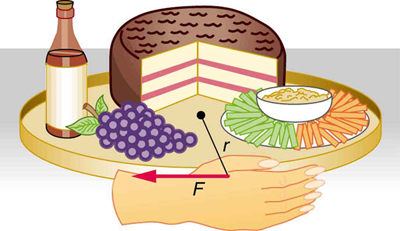
Strategy
We can find the angular momentum by solving [latex]\text{net}\phantom{\rule{0.25em}{0ex}}\tau =\frac{\text{Δ}L}{\text{Δ}t}[/latex] for [latex]\text{Δ}L[/latex], and using the given information to calculate the torque. The final angular momentum equals the change in angular momentum, because the lazy Susan starts from rest. That is, [latex]\text{Δ}L=L[/latex]. To find the final velocity, we must calculate [latex]\omega[/latex] from the definition of [latex]L[/latex] in [latex]L=\mathrm{I\omega }[/latex].
Solution for (a)
Solving [latex]\text{net}\phantom{\rule{0.25em}{0ex}}\tau =\frac{\text{Δ}L}{\text{Δ}t}[/latex] for [latex]\text{Δ}L[/latex] gives
Because the force is perpendicular to [latex]r[/latex], we see that [latex]\text{net}\phantom{\rule{0.25em}{0ex}}\tau =\text{rF}[/latex], so that
Solution for (b)
The final angular velocity can be calculated from the definition of angular momentum,
Solving for [latex]\omega[/latex] and substituting the formula for the moment of inertia of a disk into the resulting equation gives
And substituting known values into the preceding equation yields
Discussion
Note that the imparted angular momentum does not depend on any property of the object but only on torque and time. The final angular velocity is equivalent to one revolution in 8.71 s (determination of the time period is left as an exercise for the reader), which is about right for a lazy Susan.
Example 70.3: Calculating the Torque in a Kick
The person whose leg is shown in Figure 70.2 kicks his leg by exerting a 2000-N force with his upper leg muscle. The effective perpendicular lever arm is 2.20 cm. Given the moment of inertia of the lower leg is [latex]1.25 kg\cdot {\text{m}}^{2}[/latex], (a) find the angular acceleration of the leg. (b) Neglecting the gravitational force, what is the rotational kinetic energy of the leg after it has rotated through [latex]\text{57}\text{.}3º[/latex] (1.00 rad)?

Strategy
The angular acceleration can be found using the rotational analog to Newton’s second law, or [latex]\alpha =\text{net}\phantom{\rule{0.25em}{0ex}}\tau /I[/latex]. The moment of inertia [latex]I[/latex] is given and the torque can be found easily from the given force and perpendicular lever arm. Once the angular acceleration [latex]\alpha[/latex] is known, the final angular velocity and rotational kinetic energy can be calculated.
Solution to (a)
From the rotational analog to Newton’s second law, the angular acceleration [latex]\alpha[/latex] is
Because the force and the perpendicular lever arm are given and the leg is vertical so that its weight does not create a torque, the net torque is thus
Substituting this value for the torque and the given value for the moment of inertia into the expression for [latex]\alpha[/latex] gives
Solution to (b)
The final angular velocity can be calculated from the kinematic expression
or
because the initial angular velocity is zero. The kinetic energy of rotation is
so it is most convenient to use the value of [latex]{\omega }^{2}[/latex] just found and the given value for the moment of inertia. The kinetic energy is then
Discussion
These values are reasonable for a person kicking his leg starting from the position shown. The weight of the leg can be neglected in part (a) because it exerts no torque when the center of gravity of the lower leg is directly beneath the pivot in the knee. In part (b), the force exerted by the upper leg is so large that its torque is much greater than that created by the weight of the lower leg as it rotates. The rotational kinetic energy given to the lower leg is enough that it could give a ball a significant velocity by transferring some of this energy in a kick.
Making Connections: Conservation Laws
Angular momentum, like energy and linear momentum, is conserved. This fundamental principle reveals deep connections across physical systems. Angular momentum remains constant when no net external torque acts on a system, just as linear momentum is conserved when no net external force acts.
Conservation of Angular Momentum
Why does Earth continue to spin without stopping? The answer lies in the principle of angular momentum conservation. As we’ve learned, a torque is needed to change angular momentum:
Since Earth has a huge angular momentum, it would take a very large torque over a very long time to slow it significantly. In reality, tidal friction caused by the Moon and Sun does apply a torque—but it is small. Over hundreds of millions of years, this friction slowly slows Earth’s rotation. For example, scientific evidence suggests that 900 million years ago, a full day lasted only about 18 hours.
We now arrive at a fundamental law in rotational motion: if the net torque is zero, angular momentum is conserved. Mathematically:
Which implies:
Therefore,
or
This is the law of conservation of angular momentum. It tells us that in the absence of external torques, an object’s rotational motion continues unchanged. This principle is widely observed—from rotating molecules and cells to orbiting planets.
An engaging example of this law can be seen in ice skating. Consider an ice skater spinning with arms outstretched (Figure 70.3). Because there’s almost no friction between the skate blade and the ice, the net torque is practically zero. That means angular momentum is conserved. When the skater pulls in her arms, she reduces her moment of inertia [latex]I[/latex]. Since angular momentum [latex]L[/latex] must remain constant, her angular velocity [latex]\omega[/latex] increases dramatically:
Here, [latex]I'[/latex] is smaller than [latex]I[/latex], so [latex]\omega'[/latex] must be larger than [latex]\omega[/latex]. This results in a much faster spin. The same physics governs rotations in diving, gymnastics, and even the spinning motion of cells under certain biological forces.
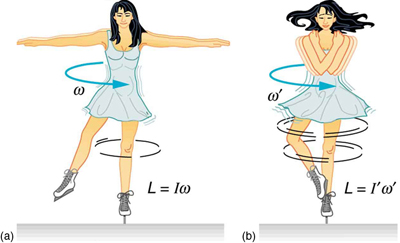
Example 70.4: Calculating the Angular Momentum of a Spinning Skater
Suppose an ice skater, such as the one in Figure 70.3, is spinning at 0.800 rev/ s with her arms extended. She has a moment of inertia of [latex]2\text{.}\text{34}\phantom{\rule{0.25em}{0ex}}\text{kg}\cdot {\text{m}}^{2}[/latex] with her arms extended and of [latex]0\text{.}\text{363}\phantom{\rule{0.25em}{0ex}}\text{kg}\cdot {\text{m}}^{2}[/latex]with her arms close to her body. (These moments of inertia are based on reasonable assumptions about a 60.0-kg skater.) (a) What is her angular velocity in revolutions per second after she pulls in her arms? (b) What is her rotational kinetic energy before and after she does this?
Strategy
In the first part of the problem, we are looking for the skater’s angular velocity [latex]\omega \prime[/latex] after she has pulled in her arms. To find this quantity, we use the conservation of angular momentum and note that the moments of inertia and initial angular velocity are given. To find the initial and final kinetic energies, we use the definition of rotational kinetic energy given by
Solution for (a)
Because torque is negligible (as discussed above), the conservation of angular momentum given in [latex]\mathrm{I\omega }=I\prime \omega \prime[/latex] is applicable. Thus,
or
Solving for [latex]\omega \prime[/latex]and substituting known values into the resulting equation gives
Solution for (b)
Rotational kinetic energy is given by
The initial value is found by substituting known values into the equation and converting the angular velocity to rad/s:
The final rotational kinetic energy is
Substituting known values into this equation gives
Discussion
In both parts, there is an impressive increase. First, the final angular velocity is large, although most world-class skaters can achieve spin rates about this great. Second, the final kinetic energy is much greater than the initial kinetic energy. The increase in rotational kinetic energy comes from work done by the skater in pulling in her arms. This work is internal work that depletes some of the skater’s food energy.
There are many fascinating examples where the conservation of angular momentum helps explain natural and biological phenomena. One dramatic case is a tornado. Storm systems in the atmosphere often rotate slowly over large areas. When part of the rotating system contracts and the radius decreases—such as in the formation of a tornado—the angular velocity increases dramatically. This is exactly like a figure skater pulling in her arms to spin faster. Conservation of angular momentum ensures that when moment of inertia decreases, the rotation rate increases.
A larger-scale example is the formation of Earth and the Solar System. Billions of years ago, a massive cloud of gas and dust slowly rotated in space (Figure 70.4). As gravity pulled the cloud inward, its size decreased and the rotation rate increased due to conservation of angular momentum. This is why planets orbit the Sun and spin in the same general direction—the rotation of that original cloud was passed on to the entire system.
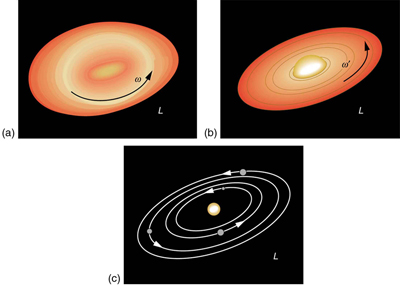
Angular momentum conservation also applies to human motion in specific environments. On Earth, our interaction with the ground often prevents angular momentum from being conserved because torques are exerted through contact forces. But astronauts aboard the International Space Station experience something different. If they are floating and not pushing off any surface, their angular momentum remains unchanged—even if they twist or spin their limbs. Their bodies obey the law of conservation of angular momentum just like orbiting satellites or planets.
Check Your Understanding
Question: Is angular momentum completely analogous to linear momentum? What are their differences, if any?
Answer: Yes, angular and linear momentum are fully analogous in how they relate to rotational and translational motion. However, they have different units and apply to different types of motion. Unlike forms of energy, angular and linear momentum are not directly interchangeable.
Section Summary
- Every rotational concept has a translational analog. Angular momentum is defined as
[latex]L = I\,\omega[/latex]
- This mirrors linear momentum:
[latex]p = mv[/latex]
and relates to torque via
[latex]\text{net}\,\tau = \frac{\Delta L}{\Delta t}[/latex] - Angular momentum is conserved when net external torque is zero. This principle underlies phenomena ranging from tornado formation to the rotation of galaxies and astronauts floating in microgravity.
Conceptual Questions
- When you start the engine of your car with the transmission in neutral, you notice that the car rocks in the opposite sense of the engine’s rotation. Explain in terms of conservation of angular momentum. Is the angular momentum of the car conserved for long (for more than a few seconds)?
- Suppose a child walks from the outer edge of a rotating merry-go round to the inside. Does the angular velocity of the merry-go-round increase, decrease, or remain the same? Explain your answer.
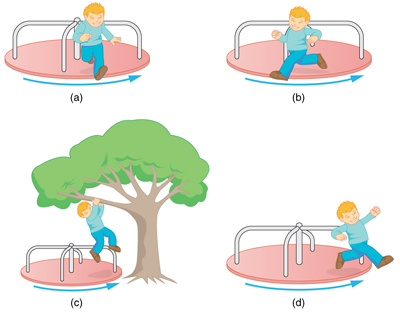
Figure 70.5: A child may jump off a merry-go-round in a variety of directions. - Suppose a child gets off a rotating merry-go-round. Does the angular velocity of the merry-go-round increase, decrease, or remain the same if: (a) He jumps off radially? (b) He jumps backward to land motionless? (c) He jumps straight up and hangs onto an overhead tree branch? (d) He jumps off forward, tangential to the edge? Explain your answers. (Refer to Figure 70.5).
- Helicopters have a small propeller on their tail to keep them from rotating in the opposite direction of their main lifting blades. Explain in terms of Newton’s third law why the helicopter body rotates in the opposite direction to the blades.
- Whenever a helicopter has two sets of lifting blades, they rotate in opposite directions (and there will be no tail propeller). Explain why it is best to have the blades rotate in opposite directions.
- Describe how work is done by a skater pulling in her arms during a spin. In particular, identify the force she exerts on each arm to pull it in and the distance each moves, noting that a component of the force is in the direction moved. Why is angular momentum not increased by this action?
- When there is a global heating trend on Earth, the atmosphere expands and the length of the day increases very slightly. Explain why the length of a day increases.
- Nearly all conventional piston engines have flywheels on them to smooth out engine vibrations caused by the thrust of individual piston firings. Why does the flywheel have this effect?
- Jet turbines spin rapidly. They are designed to fly apart if something makes them seize suddenly, rather than transfer angular momentum to the plane’s wing, possibly tearing it off. Explain how flying apart conserves angular momentum without transferring it to the wing.
- An astronaut tightens a bolt on a satellite in orbit. He rotates in a direction opposite to that of the bolt, and the satellite rotates in the same direction as the bolt. Explain why. If a handhold is available on the satellite, can this counter-rotation be prevented? Explain your answer.
- Competitive divers pull their limbs in and curl up their bodies when they do flips. Just before entering the water, they fully extend their limbs to enter straight down. Explain the effect of both actions on their angular velocities. Also explain the effect on their angular momenta.
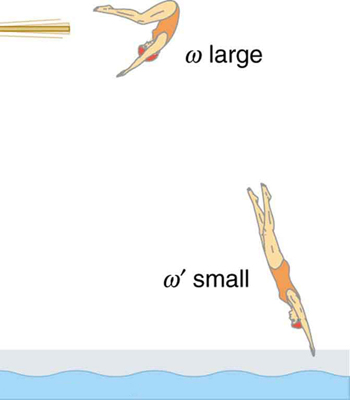
Figure 70.6: The diver spins rapidly when curled up and slows when she extends her limbs before entering the water. - Draw a free body diagram to show how a diver gains angular momentum when leaving the diving board.
- In terms of angular momentum, what is the advantage of giving a football or a rifle bullet a spin when throwing or releasing it?
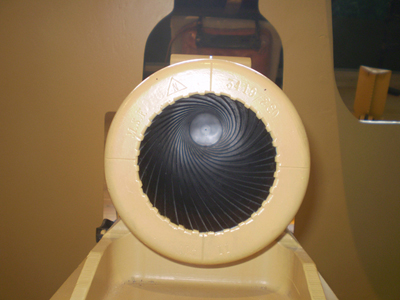
Figure 70.7: The image shows a view down the barrel of a cannon, emphasizing its rifling. Rifling in the barrel of a canon causes the projectile to spin just as is the case for rifles (hence the name for the grooves in the barrel). (credit: Elsie esq., Flickr)
Problems & Exercises
- (a) Calculate the angular momentum of the Earth in its orbit around the Sun. (b) Compare this angular momentum with the angular momentum of Earth on its axis.
- The angular momentum of the Earth in its orbit around the Sun is [latex]3\text{.}\text{77}×{\text{10}}^{6}[/latex] times larger than the angular momentum of the Earth around its axis. (a) What is the angular momentum of the Moon in its orbit around Earth? (b) How does this angular momentum compare with the angular momentum of the Moon on its axis? Remember that the Moon keeps one side toward Earth at all times. (c) Discuss whether the values found in parts (a) and (b) seem consistent with the fact that tidal effects with Earth have caused the Moon to rotate with one side always facing Earth.
- Suppose you start an antique car by exerting a force of 300 N on its crank for 0.250 s. What angular momentum is given to the engine if the handle of the crank is 0.300 m from the pivot and the force is exerted to create maximum torque the entire time?
- A playground merry-go-round has a mass of 120 kg and a radius of 1.80 m and it is rotating with an angular velocity of 0.500 rev/s. What is its angular velocity after a 22.0-kg child gets onto it by grabbing its outer edge? The child is initially at rest.
- Three children are riding on the edge of a merry-go-round that is 100 kg, has a 1.60-m radius, and is spinning at 20.0 rpm. The children have masses of 22.0, 28.0, and 33.0 kg. If the child who has a mass of 28.0 kg moves to the center of the merry-go-round, what is the new angular velocity in rpm?
- (a) Calculate the angular momentum of an ice skater spinning at 6.00 rev/s given his moment of inertia is [latex]0\text{.}\text{400}\phantom{\rule{0.25em}{0ex}}\text{kg}\cdot {\text{m}}^{2}[/latex]. (b) He reduces his rate of spin (his angular velocity) by extending his arms and increasing his moment of inertia. Find the value of his moment of inertia if his angular velocity decreases to 1.25 rev/s. (c) Suppose instead he keeps his arms in and allows friction of the ice to slow him to 3.00 rev/s. What average torque was exerted if this takes 15.0 s?
- Construct Your Own Problem Consider the Earth-Moon system. Construct a problem in which you calculate the total angular momentum of the system including the spins of the Earth and the Moon on their axes and the orbital angular momentum of the Earth-Moon system in its nearly monthly rotation. Calculate what happens to the Moon’s orbital radius if the Earth’s rotation decreases due to tidal drag. Among the things to be considered are the amount by which the Earth’s rotation slows and the fact that the Moon will continue to have one side always facing the Earth.
Glossary
- angular momentum
- the product of moment of inertia and angular velocity
- law of conservation of angular momentum
- angular momentum is conserved, i.e., the initial angular momentum is equal to the final angular momentum when no external torque is applied to the system
the product of moment of inertia and angular velocity
angular momentum is conserved, i.e., the initial angular momentum is equal to the final angular momentum when no external torque is applied to the system

